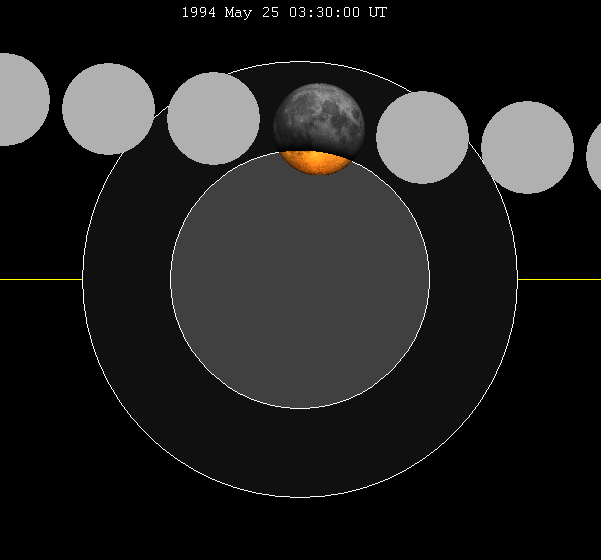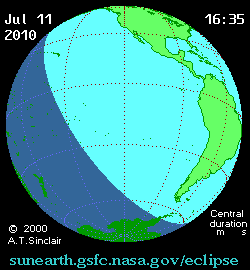|
Solar Eclipse Of May 31, 2003
An annular solar eclipse occurred at the Moon's ascending node of the orbit on May 31, 2003. A solar eclipse occurs when the Moon passes between Earth and the Sun, thereby totally or partly obscuring the image of the Sun for a viewer on Earth. An annular solar eclipse occurs when the Moon's apparent diameter is smaller than the Sun's, blocking most of the Sun's light and causing the Sun to look like an annulus (ring). An annular eclipse appears as a partial eclipse over a region of the Earth thousands of kilometres wide. Annularity was visible across central Greenland, the Faroe Islands, Iceland, Jan Mayen and northern Scotland. Partiality was visible throughout Europe, Asia, and far northwestern Canada. Images File:Garrulus - Eclips boven Chassepierre (by).jpg, Chassepierre, Belgium File:Eclipse--31-05-2003-2.jpg, From Belfort, France File:Sunrise Eclipse 2003 May 31.jpg, Wonneberg, Germany File:20030531 Oria (30847677046).jpg, From Oria, Italy File:Sun eclipse venice 5.3 ... [...More Info...] [...Related Items...] OR: [Wikipedia] [Google] [Baidu] |
Solar Eclipse
A solar eclipse occurs when the Moon passes between Earth and the Sun, thereby obscuring the view of the Sun from a small part of the Earth, totally or partially. Such an alignment occurs during an eclipse season, approximately every six months, during the new moon phase, when the Moon's orbital plane is closest to the plane of the Earth's orbit. In a total eclipse, the disk of the Sun is fully obscured by the Moon. In partial and annular eclipses, only part of the Sun is obscured. Unlike a lunar eclipse, which may be viewed from anywhere on the night side of Earth, a solar eclipse can only be viewed from a relatively small area of the world. As such, although total solar eclipses occur somewhere on Earth every 18 months on average, they recur at any given place only once every 360 to 410 years. If the Moon were in a perfectly circular orbit and in the same orbital plane as Earth, there would be total solar eclipses once a month, at every new moon. Instead, because the Moon ... [...More Info...] [...Related Items...] OR: [Wikipedia] [Google] [Baidu] |
Oria, Italy
Oria (or ''Orra'', la, Uria; grc, Ὑρία, translit=Huría or , '; he, אוריה, translit=uriya) is a town and ''comune'' in the Apulia region, in the province of Brindisi, in southern Italy. It is the seat of the Roman Catholic Diocese of Oria. History In classical times, Oria was known as ''Hyria (Uria)'' or ''Hyrium'', a city in ancient Messapia and one of the principal Messapian cities. It was just north of the ancient town Manduria, at some distance southwest of Brundisium, and southeast of Taras/Tarentum; corresponding to the location of the modern town. According to Herodotus (7.170), it was founded by the Messapians (who according to Herodotus were originally Cretans) sometime after the abortive siege of the Sicanian city Camicus. Messapians were probably of Illyrian origin. Between 217 and 84 BC the city was minting its own coins. The coins often feature '' Iapagus'', the Iapygian national hero. Hyria was conquered by the Romans. It was destroyed in AD 9 ... [...More Info...] [...Related Items...] OR: [Wikipedia] [Google] [Baidu] |
June 2012 Lunar Eclipse
June is the sixth month of the year in the Julian and Gregorian calendars and is the second of four months to have a length of 30 days, and the third of five months to have a length of less than 31 days. June contains the summer solstice in the Northern Hemisphere, the day with the most daylight hours, and the winter solstice in the Southern Hemisphere, the day with the fewest daylight hours (excluding polar regions in both cases). June in the Northern Hemisphere is the seasonal equivalent to December in the Southern Hemisphere and vice versa. In the Northern Hemisphere, the beginning of the traditional astronomical summer is 21 June (meteorological summer begins on 1 June). In the Southern Hemisphere, meteorological winter begins on 1 June. At the start of June, the sun rises in the constellation of Taurus; at the end of June, the sun rises in the constellation of Gemini. However, due to the precession of the equinoxes, June begins with the sun in the astrological sign of Gem ... [...More Info...] [...Related Items...] OR: [Wikipedia] [Google] [Baidu] |
May 1994 Lunar Eclipse
A partial lunar eclipse A lunar eclipse occurs when the Moon moves into the Earth's shadow. Such alignment occurs during an eclipse season, approximately every six months, during the full moon phase, when the Moon's orbital plane is closest to the plane of the Earth ... took place on Wednesday, May 25, 1994, the first of two lunar eclipses in 1994, the second being with a penumbral lunar eclipse on Friday, November 18. Visibility Related eclipses Eclipses of 1994 * An annular solar eclipse on May 10. * A partial lunar eclipse on May 25. * A total solar eclipse on November 3. * A penumbral lunar eclipse on November 18. Lunar year series Half-Saros cycle A lunar eclipse will be preceded and followed by solar eclipses by 9 years and 5.5 days (a half saros).Mathematical Astronomy Morsels, Jean Meeus, p.110, Chapter 18, ''The half-saros'' This lunar eclipse is related to two solar eclipses of Solar Saros 147. See also * List of lunar eclipses * List of 20 ... [...More Info...] [...Related Items...] OR: [Wikipedia] [Google] [Baidu] |
Solar Eclipse Of July 11, 2010
The total solar eclipse of July 11, 2010, occurred over the southern Pacific Ocean. A solar eclipse occurs when the Moon passes between Earth and the Sun, thereby totally or partly obscuring the image of the Sun for a viewer on Earth. A total solar eclipse occurs when the Moon's apparent diameter is larger than the Sun's, blocking all direct sunlight, turning day into darkness. Totality occurs in a narrow path across Earth's surface, with the partial solar eclipse visible over a surrounding region thousands of kilometres wide. This eclipse was on the same day as the 2010 FIFA World Cup Final. Visibility The eclipse on this day was one of the most remote in recorded history. It was visible over much of the southern Pacific Ocean, touching several atolls in French Polynesia, the Cook Islands, Easter Island, and Argentina's Patagonian plains. Fred Espenak, a NASA astrophysicist, said: In French Polynesia, the eclipse was seen with 98 percent totality. During that time, the diamond ... [...More Info...] [...Related Items...] OR: [Wikipedia] [Google] [Baidu] |
Solar Eclipse Of April 17, 1996
A partial solar eclipse occurred on April 17, 1996. A solar eclipse occurs when the Moon passes between Earth and the Sun The Sun is the star at the center of the Solar System. It is a nearly perfect ball of hot plasma, heated to incandescence by nuclear fusion reactions in its core. The Sun radiates this energy mainly as light, ultraviolet, and infrared radi ..., thereby totally or partly obscuring the image of the Sun for a viewer on Earth. A partial solar eclipse occurs in the polar regions of the Earth when the center of the Moon's shadow misses the Earth. Images Related eclipses Eclipses of 1996 * A total lunar eclipse on April 4. * A partial solar eclipse on April 17. * A total lunar eclipse on September 27. * A partial solar eclipse on October 12. Solar eclipses 1993–1996 Metonic series References External links NASA graphics 1996 4 17 1996 in science 1996 4 17 April 1996 events {{Solar-eclipse-stub ... [...More Info...] [...Related Items...] OR: [Wikipedia] [Google] [Baidu] |
Solar Eclipse Of November 23, 2003
A total solar eclipse took place on November 23, 2003, with a magnitude of 1.0379. A solar eclipse occurs when the Moon passes between Earth and the Sun, thereby totally or partly obscuring the image of the Sun for a viewer on Earth. A total solar eclipse occurs when the Moon's apparent diameter is larger than the Sun's, blocking all direct sunlight, turning day into darkness. Totality occurs in a narrow path across Earth's surface, with the partial solar eclipse visible over a surrounding region thousands of kilometres wide. It was visible from a corridor in the Antarctic region. A partial eclipse was seen from the much broader path of the Moon's penumbra, including the southern tip of South America and most of Australia. For most solar eclipses the path of totality moves eastwards. In this case the path moved south and then west round Antarctica. Images Animated map Related eclipses Eclipse season This is the second eclipse this season. First eclipse this season: 9 N ... [...More Info...] [...Related Items...] OR: [Wikipedia] [Google] [Baidu] |
November 2003 Lunar Eclipse
A total lunar eclipse took place on Sunday, November 9, 2003, the second of two total lunar eclipses in 2003, the first being on May 16, 2003. It is the first total lunar eclipse of 21st century which happened on a micromoon day. The Moon barely edged into total eclipse for 21 minutes and 58 seconds. With the Moon just 1.78% of its diameter into the Earth's umbral shadow, the Moon may have been quite bright, but even so, this should have been worth seeing. The partial eclipse lasted for 3 hours, 31 minutes and 25 seconds. Occurring only 1.4 days before apogee (Apogee on Monday, November 10, 2003), the Moon's apparent diameter was 6.4% smaller than average. This was the last of 14 total lunar eclipses of Lunar Saros 126, which started on 19 June 1769 and ended on 9 November 2003. Visibility It was completely visible over Americas, Europe, Africa and central Asia, seen rising over the Americas and setting over central Asia. Photo gallery Image:Eclipse01.jpg, Grand Rapids, MI, ... [...More Info...] [...Related Items...] OR: [Wikipedia] [Google] [Baidu] |
May 2003 Lunar Eclipse
A total lunar eclipse took place on Friday, May 16, 2003, the first of two total lunar eclipses in 2003, the other being on November 9, 2003. A shallow total eclipse saw the Moon in relative darkness for 52 minutes and 3.1 seconds. The Moon was 12.938% of its diameter into the Earth's umbral shadow, and should have been significantly darkened. The partial eclipse lasted for 3 hours, 15 minutes and 3.1 seconds in total. Occurring only 0.5 days after perigee (Perigee on Thursday, May 15, 2003), the Moon's apparent diameter was 6.2% larger than average. At greatest eclipse the Moon was only 357,693 km (222,260 mi) from the Earth, making it a Super Full Moon. This lunar eclipse is first of a ''tetrad'', four total lunar eclipses in series. The previous series was in 1985 and 1986, starting with a May 1985 lunar eclipse. The next one was in 2014 and 2015, starting with the April 15, 2014 lunar eclipse. Visibility It was completely visible over central Pacific, North America, Sout ... [...More Info...] [...Related Items...] OR: [Wikipedia] [Google] [Baidu] |
Eclipse Season
An eclipse season is the period, roughly every six months, when eclipses occur. Eclipse seasons are the result of the axial parallelism of the Moon's tilted orbital plane ( tilted five degrees to the Earth's orbital plane), just as Earth's weather seasons are the result of the axial parallelism of Earth's tilted axis as it orbits around the Sun. During the season, the "lunar nodes" – the line where the Moon's orbital plane intersects with the Earth's orbital plane – aligns with the Sun and Earth, such that a solar eclipse is formed during the new moon phase and a lunar eclipse is formed during the full moon phase. Only two (or occasionally three) eclipse seasons occur during each year, and each season lasts about 35 days and repeats just short of six months later, thus two full eclipse seasons always occur each year. Either two or three eclipses happen each eclipse season. During the eclipse season, the Moon is at a low ecliptic latitude (less than around 1.5° north or ... [...More Info...] [...Related Items...] OR: [Wikipedia] [Google] [Baidu] |
Grantown-on-Spey
Grantown-on-Spey ( gd, Baile nan Granndach) is a town in the Highland Council Area, Counties of Scotland, historically within the county of Moray. It is located on a low plateau at Freuchie beside the river Spey at the northern edge of the Cairngorms, Cairngorm mountains, about south-east of Inverness ( by road). The town was founded in 1765 as a New town, planned settlement and was originally called simply Grantown after Sir James Grant, 8th Baronet, Sir James Grant. The addition 'on Spey' was added by the burgh council in 1898. The town has several listed 18th and 19th century buildings, including several large hotels and serves as a regional centre for tourism and services in the Strathspey, Scotland, Strathspey region. The town is twinned with Notre-Dame-de-Monts in the Vendée, Pays de la Loire, France. History The burgh was founded in 1765 during the early stages of the Industrial Revolution to encourage both agricultural marketing and handicrafts, as well as to increa ... [...More Info...] [...Related Items...] OR: [Wikipedia] [Google] [Baidu] |
Ringerike (municipality)
Ringerike is a municipality in the traditional and electoral district Buskerud in Viken county, Norway. It is part of the traditional region of Ringerike. The administrative centre of the municipality is the town of Hønefoss. The municipality of Ringerike was created on 1 January 1964 after the merger of the town of Hønefoss and the rural municipalities of Hole, Norderhov, Tyristrand, and Ådal. However, the area of Hole was removed from the municipality of Ringerike on 1 January 1977 to become a separate municipality once again. The historic area of Ringerike included not just the modern municipality of Ringerike but also Hole and Krødsherad, Modum and Sigdal. General information Etymology The Old Norse form of this name was ''Hringaríki''. The first element is (probably) the genitive plural of ''hringir'', the name of an old Germanic tribe. The last element is ''ríki'' n 'kingdom, reich'. (See also Romerike.) Coat of arms The coat of arms were granted on 16 June 1967. ... [...More Info...] [...Related Items...] OR: [Wikipedia] [Google] [Baidu] |


.jpg)





